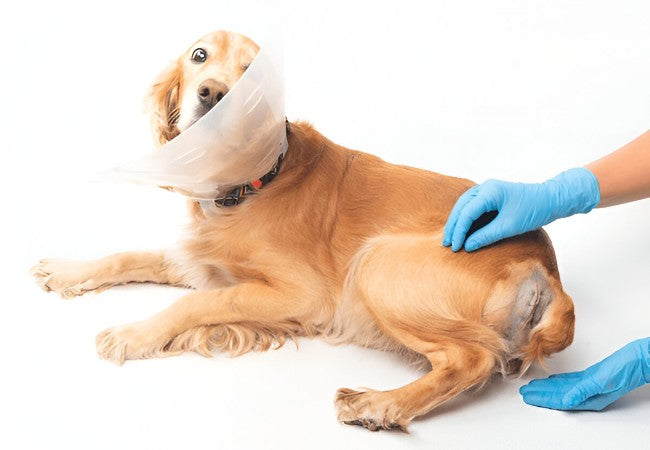Veterinary Guide to Canine Inguinal Hernia 2025 🩺🐶

In this article
Veterinary Guide to Canine Inguinal Hernias 2025 🩺🐶
By Dr. Duncan Houston BVSc
🧬 What Is an Inguinal Hernia?
An inguinal hernia is the protrusion of abdominal contents (fat, intestines, bladder, or uterus) through the inguinal canal in the groin area. In both male and female dogs, congenital weakness or trauma may cause the abdominal wall to open, permitting tissue to move through.
👥 Causes & Risk Factors
- Congenital: Common in puppies; genetic predisposition suspected in breeds such as Basenjis, Pekingese, Cocker Spaniels, Dachshunds, Poodles, Cairn Terriers, and West Highland White Terriers.
- Traumatic or acquired: Injury or intense strain disrupting the caudal abdominal muscles.
- Hormonal and physiological changes: In intact bitches, pregnancy or estrus may enlarge the canal; obesity and older intact females are at ʻgreater risk.
👀 Clinical Signs
- Soft, sometimes reducible swelling in the groin near thighs—bilateral or unilateral.
- Discomfort or pain when palpated, especially in strangulated cases.
- Signs of organ entrapment: vomiting, anorexia, difficulty urinating, straining, or gastrointestinal symptoms.
🔍 Diagnosis
- Physical exam: Palpation often confirms reducible mass; irreducible masses suggest complications.
-
Imaging:
- Ultrasound—assesses contents (fat, bowel, bladder), reducibility, and strangulation.
- Radiographs with contrast can visualize bowel or bladder loops.
- Advanced imaging (CT/MRI) for complex cases.
- Fine-needle aspirate: Occasionally used for differentiation—but caution to avoid organ injury.
⚙️ Treatment & Surgical Repair
1. Timing of Surgery
- Immediate surgery if strangulation or organ entrapment is present.
- Elective repair is appropriate in asymptomatic hernias—ideally before complications arise.
2. Surgical Technique
- Exploratory celiotomy: Return hernia contents to abdomen, assess viability, resect necrotic tissue if needed.
- Herniorrhaphy: Debridement and closure of the inguinal ring—using permanent sutures and mesh for large defects.
- Concomitant neuter/spay: In intact dogs to reduce hormonal triggers; caution and hygiene required in pregnant bitches.
3. Postoperative Care
- Pain relief with analgesics (gabapentin, tramadol, NSAIDs).
- Restrict activity for ~10–14 days; use Elizabethan collar to prevent surgical site trauma.
- Monitor for signs of complications: swelling, erythema, discharge, or systemic signs.
4. Complications & Prognosis
- Mortality rate ~3%; postoperative complications in 17%—including infection, dehiscence, recurrence, or peritonitis—often linked to bowel necrosis.
- Uncomplicated repairs have an excellent prognosis ▶ VCA: “excellent prognosis for a full recovery”.
- Delayed surgery or organ ischemia raises a guarded prognosis.
📈 Long‑Term Monitoring
- Recheck surgical site at 7–14 days for healing and mesh stability.
- Activity gradually restored over 4–6 weeks.
- Monitor for hernia recurrence and ensure neuter status to reduce risk.
- Annual wellness exams focusing on abdominal integrity.
🏠 Home & Preventive Care
- Maintain healthy weight to minimize abdominal strain.
- Supervise to prevent trauma or excessive jumping.
- Avoid breeding affected dogs—congenital hernias are heritable.
📱 Ask A Vet Telehealth Support
- 📸 Owners upload pre- and post-surgical site photos for visual triage and healing updates.
- 🔔 Medication reminders for pain relief and antibiotics.
- 🩺 Schedule remote physical checks and alerts for vet visits.
🎓 Case Spotlight: “Molly” the Dachshund
Molly, a 7-week-old Dachshund pup, had a reducible groin bulge noticed at vaccination. Ultrasound confirmed inguinal hernia containing omentum. At 10 weeks, she underwent elective herniorrhaphy with suture repair. Postoperative campaign: 10-day exercise restriction, pain control, and mobile photo check-ins. Molly recovered fully with no recurrence at annual re-evaluate. 🐕⚕️
🔚 Key Takeaways
- Inguinal hernias result from congenital or acquired weakness in the inguinal canal, leading to groin swelling and possible organ entrapment.
- Surgical repair—ideally before complications—using suture or mesh; neutering often included.
- Excellent prognosis in uncomplicated cases; complications like strangulation increase risk.
- Ask A Vet telehealth offers support with remote wound assessment, medication reminders, diet guidance, and follow-ups. 🐾📲
Dr Duncan Houston BVSc, founder of Ask A Vet. Download the Ask A Vet app today to guide your dog’s recovery from inguinal hernia surgery—from wound monitoring to medication reminders, weight management, and long‑term wellness support 🐶📲






